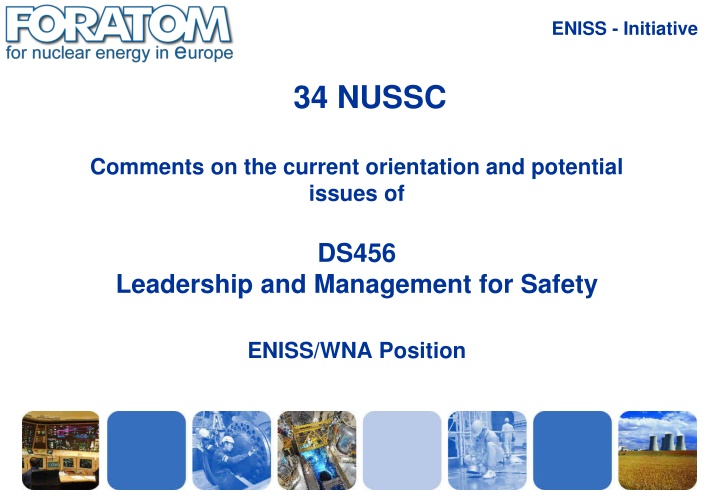
Enhancing Safety Management: ENISS Initiatives and Feedback on GS-R-3 Implementation
Explore ENISS initiatives focusing on enhancing safety management, feedback on GS-R-3 implementation, and ways organizations can utilize the new safety requirements publication for better safety practices and management.
Download Presentation

Please find below an Image/Link to download the presentation.
The content on the website is provided AS IS for your information and personal use only. It may not be sold, licensed, or shared on other websites without obtaining consent from the author. If you encounter any issues during the download, it is possible that the publisher has removed the file from their server.
You are allowed to download the files provided on this website for personal or commercial use, subject to the condition that they are used lawfully. All files are the property of their respective owners.
The content on the website is provided AS IS for your information and personal use only. It may not be sold, licensed, or shared on other websites without obtaining consent from the author.
E N D
Presentation Transcript
ENISS - Initiative 34 NUSSC Comments on the current orientation and potential issues of DS456 Leadership and Management for Safety ENISS/WNA Position
ENISS - Initiative DPP 456: Justification Main reasons for revising the GS-R-3 from 2006 to reinforce safety, better align it with the Safety Fundamental SF-1-Principles 1 & 3 and at the same time take into account the feedback on experience of application from member states. to reflect the new long-term structure for safety standards. In order to facilitate the implementation of the new requirements by the users, the part dedicated to the integrated management system will keep as much as possible the structure of the existing document 2
ENISS - Initiative DPP 456: The requirements established in the new publication may be used by organizations in the following ways: As the basis for organizations directly responsible for operating facilities and activities and providing services; As the basis for the regulation of these facilities and activities by the regulatory body; By the licensee, to specify to a supplier, via contractual documentation, any specific requirements of this Safety Requirements publication that must be included in the supplier s management system for the supply of items and services. 3
ENISS - Initiative General feedback on GS-R-3 Implementation: Safety must be the fundamental basis of this document and shall have the highest priority. Integration to be reinforced that other businesses do not reduce or impact safety. Line management responsibility and accountability for safety to be emphasized. Interaction between line management and process management to be addressed. Clarification on the applicability to vendors, contractors and suppliers 4
ENISS - Initiative General feedback on GS-R-3 Implementation GS-R-3 could bring out the importance of organizational learning, good communication of safety issues, a sense of reality around prioritization, clarity about organizational structure and accountability.. be clearer on subjects related to improvement, resource management, management oversight, problem identification and resolution, managing organizational change. include items on organizational learning, use of experience benchmarking (inside and outside the nuclear industry), questioning attitude, human performance, configuration management Oversight of the management system could be strengthened from the perspective of organizational effectiveness assessment. 5
ENISS - Initiative Current orientation of the draft Scope of the safety requirements document has been changed from management system to leadership and management. Focused are persons, who are responsible for safety and their attitudes and skills. The future GSR part II can be applied together with: ISO 9000 focus on quality and customer satisfaction ISO 14000 focus on the environment ISO 18000 focus on industrial safety or other similar standards Intention is an integrated Management System, where Safety Management is integrated and Nuclear Safety is not compromised. 6
ENISS - Initiative Current orientation of the draft Application of DS456 is focused on license holders operating a facility or conducting an activity that give rise to radiation risk activities. Is in line with the scope of SF-1 as well as principle 1in SF-1. Reduction of the number of requirements has lead to a content in line with a General Safety Regulation Management system is described as a tool with its components and not as a self standing purpose. 7
ENISS - Initiative Current orientation of the draft Process implementation and other tools are not over emphasized and in a balance. By giving Safety Culture its own chapter is the importance of this issue is emphasized. New requirement 11 - Management of contracted parties underline the licensee overall responsibility for safety which is in line with the requirements in SSR-1. 8
ENISS - Initiative ENISS/WNA Recommendations The users of the GSR part II should primarily be the license holders. However, GSR part II should clearly put a requirement on the licensee that the management system shall include routines and processes that ensures that any relevant safety requirement is imposed on vendors and contractors. ENISS/WNA considers the current draft well balanced, emphasising nuclear safety and highlighting safety culture. However, the draft could be further enhanced by considering the general recommendations and the detailed comments on the wording made by Member states and observers. The same structure of GS-R-3 and GS-G-3.1 3.5 is user-friendly. GS-G3.1 3.5 will adopt the same structure like GSR part II. 9
ENISS - Initiative BACK UP 10
ENISS - Initiative DPP456: Objectives for revising GS-R-3 Principle 1: Responsibility for safety The prime responsibility for safety must rest with the person or organization responsible for facilities and activities that give rise to radiation risks. Principle 3: Leadership and management for safety Effective leadership and management for safety must be established and sustained in organizations concerned with, and facilities and activities that give rise to, radiation risks. 11
